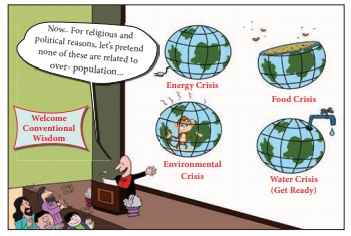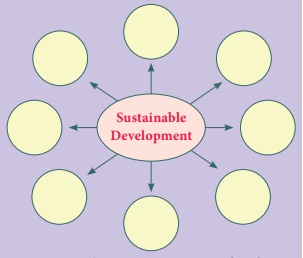Political Science - Multilateral Conferences on Environment | 12th Political Science : Chapter 12 : Environmental Concerns and Globalisation
Chapter: 12th Political Science : Chapter 12 : Environmental Concerns and Globalisation
Multilateral Conferences on Environment
Multilateral Conferences on Environment
Environmental diplomacy has become an important
subset of internationalism in the 1970s. Numerous efforts, formally and
informally, have been afoot to protect the environment at the international
level. The United Nations (UN) remains the main impetus and driver of
incorporating environmental concerns in this direction. A series of the
important conferences as follows:
Ramsar Convention, 1971
The Convention on Wetlands, also called the Ramsar Convention, is an international treaty calling for ŌĆ£the conservation and wise use of all wetlands through local and national actions and international cooperation, as a contribution towards achieving sustainable development throughout the worldŌĆØ. It was adopted at Ramsar, Iran in 1971 and came into force in 1975. The United Nations Educational, Scientific and Cultural Organisation (UNESCO) is the depository of the Convention. The Secretariat of Ramsar Convention is functioning within the headquarters of the International Union for the Conservation of Nature (IUCN) in Gland, Switzerland. On 21 August 2015, the Contracting Parties approved the Four Ramsar Strategic Plan for 2016-2024. The World Wetlands Day is celebrated on 2nd February every year. The Montreux Record is ŌĆ£a register of wetland sites on the List of Wetlands of International Importance where changes in ecological character have occurred, are occurring, or are likely to occur as a result of technological developments, pollution or other human interferenceŌĆØ. It is maintained as part of the Ramsar List. Under the three pillars of the Convention, the contracting parties commit to:
1) Work towards the wise use of all their wetlands
2) Designate suitable wetlands for the list of
Wetlands of International Importance (the ŌĆ£Ramsar ListŌĆØ) and ensure their
effective management;
3) Cooperate internationally on trans-boundary
wetlands, shared wetland systems and shared species.
The World Heritage Convention, 1972
The World Heritage Convention in 1972 sought to identify
and protect the worldŌĆÖs natural and cultural heritage considered to be of
Outstanding Universal Value. It defines the criteria for the selection of
natural and cultural sites to be inscribed on the UNESCOŌĆÖs World Heritage List.
The enforcement of the Convention is carried out through the Operational
Guidelines, which reflects the procedures for new inscriptions, site
protection, danger-listings, and the provision of international assistance
under the World Heritage Fund. Moreover, the Convention is administered by the
World Heritage Committee supported by the UNESCo World Heritage Centre, which
is the secretariat of the Convention based at Paris. The Committee is also assisted
by the three technical advisory committees ŌĆō IUCN, ICOMOS and ICCROM.
UN Conference on the Human Environment (1972)
The UN Conference on the Human Environment or the
Stockholm Conference was the first major multilateral conference on
environmental issues. It was held at Stockholm in Sweden from June 5-16, 1972.
The conference, which was attended by delegations from 114 governments, was a
breakthrough by scripting a new discourse on environmental politics by laying
the foundation of a global environmental governance regime based on
international cooperation. The United Nations Environment Programme (UNEP), was
also an institutional innovation of the Stockholm Conference
Convention on International Trade in Endangered Species of Wild flora and fauna (CITES), 1973
As an output of the 1973 resolution of the
International Union for Conservation of Nature (IUCN), the CITES, which took
place at Washington, seeks to control or prevent international commercial trade
in endangered species or products derived from them. It is not a direct attempt
towards the protection of the endangered species but aims to reduce the economic
incentive that triggers the poaching of endangered species and the destruction
of their habitat. Hence, the Convention seeks to eliminate this illicit market
by decimating the end-user demand. The CITES, also called the Washington
Convention entered into force in 1975.
Convention on Migratory Species, 1979

The Convention on the Conservation of Migratory
Species of Wild Animals, also known as the Convention on Migratory Species
(CMS) or the Bonn Convention, which came into force 1983, seeks to ŌĆ£conserve
terrestrial, marine and avian migratory species throughout their rangeŌĆØ. It
proposed strict protective measures for endangered migratory species. Besides,
multilateral agreements for the conservation and management of migratory
species along with cooperative research activities which constitute the mandate
of the Convention. Appendix I of the Convention deals with the list of
migratory species that are categorized as endangered which requires immediate
international cooperation to mitigate the same. On the other hand, Appendix II
is a composite of other species that require significant attention or benefit
from international agreements under the Convention.
Vienna Convention for the Protection of Ozone Layer, 1985
The Vienna Convention for the Protection of the
Ozone Layer is a multilateral environmental agreement, which kick-started
global cooperation for the protection of EarthŌĆÖs ozone layer. It was adopted on
22 March 1985. Subsequently, the Montreal Protocol on Substances that Deplete
the Ozone Layer was adopted on 16 September 1987 which came into effect in
1989. This international treaty looks into eliminating the use of ozone-
depleting substances (ODS). The Ozone Secretariat located at Nairobi, Kenya is
the Secretariat for both the Vienna Convention and Montreal Protocol.
World Commission on Environment and Development, 1987
The World Commission on Environment and Development
(WCED), also known as the Brundtland Commission after its chairperson Gro Harlem
Brundtland, helped chalk out the strategies for environmental conservation and
sustainable development. Its final report titled Our Common Future, published
in 1987 underscores the interdependence of environmental protection with other
factors like economic development and energy production and have become the
lynchpin of the international environmental law until now. The idea of
sustainable development received the first-ever official definition under this
initiative.
Basel Convention on Trans-boundary Movement of Hazardous Wastes, 1989
The Basel Convention which came into force in 1992,
was a response to NIMBY (Not in My Back Yard) syndrome, that grappled the
industrialized world in the 1980s with regard to the heightening concerns about
the hazardous wastes and the public resistance to it resulting in an upsurge of
disposal costs. It created a market for hazardous wastes particularly in the
environmentally-less-conscious Least Developed Countries (LDCs) which offered
cheap disposal alternatives. The Convention sought to reduce the trans-boundary
movement of hazardous wastes by taking necessary steps to minimize the creation
of such wastes along with measures to prohibit the shipment of such substances
from the developed world to the LDCs.
United Nations Conference on Environment and Development, 1992
The United Nations Conference on Environment and
Development, which also earned fame as the Earth Summit, was held on during
3-14 June 1992 at Rio de Janeiro. The Summit which is credited to be the
biggest international conference in the history of international relations,
focussed on myriad issues ranging from patterns of production to alternative
sources of energy, public transportation and the growing need for environmental
awareness. Agenda 21, the Rio Declaration on Environment and Development, the
Statement of Forest Principles, the United Nations Framework Convention on
Climate Change, and the United Nations Convention on Biological Diversity are
the documental results of the two-week summit. The Rio process also triggered
the constitution of a couple of follow-up mechanisms such as the Commission on
Sustainable Development, Inter-Agency Committee on Sustainable Development, and
the High-level Advisory Board on Sustainable Development. The conference was also
regarded as the ŌĆśParliament of the WorldŌĆÖ.

UN Convention to Combat Desertification, 1994
As the only legally binding international agreement
connecting environment and development on lines of sustainable land management,
the 1994 UN Convention to Combat Desertification (UNCCD) aims to address a
range of most vulnerable ecosystems, particularly the arid, semi-arid, and dry
sub-humid areas, known as the drylands. The newly adopted UNCCD 2018-2030
Strategic Framework, through its Land Degradation Neutrality (LDN) measures, is
a bid to restore the productivity of the degraded lands along with improving
the livelihood of people in these regions. The Secretariat of the Convention,
established in 1999, functions at Bonn in Germany. Since 2001, the Conference
of Parties (COP), which is the supreme decision-making apparatus, meets
biennially and have had 13 sessions till date. The Ankara and Changwon
Initiatives are the latest the agenda launched by the UNCCD.
General Assembly Special Session on the Environment, 1997
In a bid to review the progress of the post-Earth
Summit environmental regime, the UN General Assembly (UNGA) convened a Special
Session on Implementation of Agenda 21 during June 23-27, 1997. The session
sought to scrutinise the trajectory of the success of Agenda 21 and attempted to
evolve a new narrative on the environmental conservation by intensifying the
commitment of member states. The special session, which is also known as ŌĆ£Earth
Summit + 5ŌĆØ, adopted ŌĆ£Programme for the Further Implementation of Agenda 21,
including Statement of CommitmentŌĆØ.
Kyoto Protocol, 1997
The Kyoto Protocol, adopted on 11th December 1997,
is an international environmental treaty that enhances the scope of the UNFCCC
(1992) that imposed legal commitment on the ratified State Parties to reduce
greenhouse gas (GHG) emissions. It came into force on 16th February 2005.
Considering the historical responsibility of the developed world for the high
levels of GHG footprint, the treaty places a stringent mandate on them under
the principle of ŌĆ£common but differentiated responsibilitiesŌĆØ. The COP 7 held
at Marrakesh in Morocco in 2007 adopted the detailed framework for the
protocol. It is usually referred to as the ŌĆ£Marrakesh RecordsŌĆØ. After the first
commitment which began in 2008, the protocol was amended on 8 December 2012 at
Doha, Qatar.
The Doha Amendment to the Kyoto Protocol endorsed a
second commitment to the Annex I countries starting from 1 January 2013 to 31
December 2020. Along with a series of changes on certain Articles, the protocol
now requires the State Parties to report a revised list of GHG for the period
second commitment. Unlike the first commitment target of reducing emissions to an
average of five per cent below 1990 levels, a minimum eight per cent reduction
against the same year benchmark is expected under the second commitment. The
three market-based mechanisms identified by the Kyoto Protocol to meet the
targets are International Emissions Trading, Clean Development Mechanism and
Joint Implementation, which help support green investment and provide
cost-effective means to realize the emission targets.
World Summit on Sustainable Development, 2002
The UN-backed World Summit on Sustainable
Development took place at Johannesburg, South Africa during August 26 ŌĆō
September 6, 2002. The Convention which was informally referred to as Earth
Summit 2002 went on to resuscitate the spirit of its prequel by tabling new
challenges and concerns that affect the environmental realm. This renewed
environmentalism in the new format offered a sustainability-driven roadmap in
addressing the problems of the millennium. The Johannesburg Declaration on
Sustainable Development, the documental by-product of the summit, reemphasized
the basic tenets of the multilateral initiatives in the past with more force.
It postulated the necessity of a time- bound structure of actions expected from
the member states over an array of agreements including Agenda 21. Moreover,
the Convention succumbed to severe castigations from various quarters over its
inability to bring any new arrangement of its own.
UN Conference on Sustainable Development, 2012
The UN Conference on Sustainable Development, also known
as Rio+20, was held at Rio de Janeiro, Brazil on 20-22 June 2012. With its uncompromising
stand on rolling out an affirmative sustainable development plan, the member
states focussed on evolving a process for the development of Sustainable
Development Goals(SDGs)thatcombineswithMillennium Development Goals (MDGs).
Moreover, the adoption of ground-breaking guidelines for green economy policies
was another result of the Rio+20. The conference also sought to constitute an
inter-governmental process under the General Assembly to frame a strategy
concerning finance vis-├Ā-vis sustainable development. An agreement to establish
a high-level political forum for sustainable development was also achieved. The
report of the conference was themed ŌĆ£The Future We WantŌĆØ.
UN Sustainable Development Summit, 2015
As a high-level plenary meeting of the UNGA, the UN
Sustainable Development Summit, which spanned over 25- 27 September 2015 at the
UN Headquarters in New York, adopted the post-2015 agenda titled ŌĆ£Transforming
our World: 2030 Agenda for Sustainable DevelopmentŌĆØ. It is a composite of a
Declaration, 17 Sustainable Development Goals (SDGs) and 169 targets. The SDGs
came into effect in 2016 and will guide the discourse on sustainable
development until 2030.
The Sustainable Development Goals adopted are as follows
Goal 1:
End poverty in all its forms everywhere
Goal 2: End hunger, achieve food security
and improved nutrition and promote sustainable agriculture
Goal 3: Ensure healthy lives and promote
well-being for all at all ages
Goal 4: Ensure inclusive and equitable
quality education and promote lifelong learning opportunities for all
Goal 5: Achieve gender equality and empower
all women and girls
Goal 6: Ensure availability and sustainable
management of water and sanitation for all
Goal 7: Ensure access to affordable,
reliable, sustainable and modern energy for all
Goal 8: Promote sustained, inclusive and
sustainable economic growth, full and productive employment and decent work for
all
Goal 9: Build resilient infrastructure,
promote inclusive and sustainable industrialization and foster innovation
Goal 10: Reduce inequality within and among
countries
Goal 11: Make cities and human settlements
inclusive, safe, resilient and sustainable
Goal 12: Ensure sustainable consumption and
production patterns
Goal 13: Take urgent action to combat climate
change and its impacts
Goal 14: Conserve and sustainably use the
oceans, seas and marine resources for sustainable development
Goal 15: Protect, restore and promote
sustainable use of terrestrial ecosystems, sustainably manage forests, combat
desertification, and halt and reverse land degradation and halt biodiversity
loss
Goal 16: Promote peaceful and inclusive
societies for sustainable development, provide access to justice for all and
build effective, accountable and inclusive institutions at all levels
Goal 17: Strengthen the means of
implementation and revitalize the global partnership for sustainable
development
Paris Agreement, 2016
The Paris Agreement (LŌĆÖaccord de Paris in French)
is a multilateral agreement within the precincts of the UNFCCC. It provides an
enhanced framework for the mitigation of greenhouse gases emission, adaptation
and finance starting in the year 2020. It was opened for signature on 22 April
2016 and came into force on 4 November 2016. As an instrument to combat climate
change, the Paris Accord aims to keep global temperatures ŌĆ£well belowŌĆØ 2.0 C
(3.6 F) above pre-industrial times and ŌĆ£endeavour to limitŌĆØ them even more to,
1.5 C. It also helped reach a consensus on limiting the human-driven greenhouse
gases emission to the levels naturally absorbable by trees, soil and oceans,
between 2050 and 2100.
Apart from the mandatory periodical review every
five years to assess the contributions of the State Parties, the treaty also ensures
that the developed countries shall help LDCs in adapting with the climate
change through ŌĆ£climate financeŌĆØ to enable them to switch over to renewable
energy. Until now, 184 out of the 197 State Parties have ratified the treaty
IndiaŌĆÖs Commitment to Paris Deal
┬Ę
In anticipation of this moment,
countries publicly outlined what post-2020 climate actions they intended to take
under the new international agreement, known as their Intended Nationally
Determined contributions.
┬Ę
In its INDC, India has pledged to improve
the emissions intensity of its GDP by 33 to 35 per cent by 2030 below 2005
levels. It has also pledged to increase the share of non-fossil fuels-based
electricity to 40 per cent by 2030. It has agreed to enhance its forest cover
which will absorb 2.5 to 3 billion tonnes of carbon dioxide (CO2,
the main gas responsible for global warming) by 2030 INDCs.
┬Ę
India has also reiterated its need
for international finance and technology support to meet its climate goals. In
this regard, it has said it would require at least US $ 2.5 trillion (at
2014-15 prices) to meet its climate change actions between now and 2030.
Activity
Explore how the application of
Artificial Intelligence can help conserve environment better.
Activity
Explore the concept of Blue Economy
and its relevance.
Activity
Must watch Documentary film
Director Davis Guggenheim eloquently
weaves the science of global warming with former USA Vice President Al GoreŌĆÖs
personal history and lifelong commitment to reversing the effects of global
climate change in the most talked- about documentary of the year.

An audience and critical favorite,
ŌĆ£An Inconvenient TruthŌĆØ makes the compelling case that global warming is real,
man-made, and its effects will be cataclysmic if we donŌĆÖt act now. Gore
presents a wide array of facts and information in a thoughtful and compelling
way: often humorous, frequently emotional, and always fascinating. In the end,
An Inconvenient Truth accomplishes what all great films should: it leaves the
viewer shaken, involved and inspired.
Activity
Read about the most important
environmental movements at the national and state levels.
Activity
Have a discussion on why is
international agreements an necessary for the reduction of greenhouse gases.
Activity
Make a copy of diagrams complete it
by naming eight types of Sustainable Development Goals (SDG)

Discuss - Why is it important for future generations that development should be sustainable?
Activity
US President Donald Trump has
announced withdrawl from Paris deal. In the context the students are requested to
discuss the world response regarding post Kyoto to reduce globe warming.
Related Topics